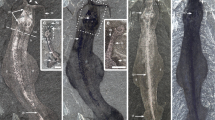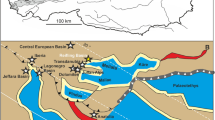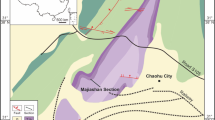Abstract
ALL agnathans (jawless vertebrates) are generally considered to have lacked a stomach, as do the living lampreys. Thelodonts are agnathans of Silurian and Devonian age whose bodies were covered by tiny, hollow, tooth-like scales which are useful for correlating rocks. We have discovered a new group of agnathans with 'thelodont' scales but with a body plan very different from that of previously known thelodonts. Sediment infillings reveal gut morphology that includes a probable stomach, suggesting that stomachs arose before jaws in vertebrate evolution. These new fork-tailed 'thelodonts9 are also the first agnathans known to have deep, compressed bodies. They represent an important new clade of early vertebrates and are potential close relatives of gnathostomes (jawed vertebrates).
This is a preview of subscription content, access via your institution
Access options
Subscribe to this journal
Receive 51 print issues and online access
$199.00 per year
only $3.90 per issue
Buy this article
- Purchase on Springer Link
- Instant access to full article PDF
Prices may be subject to local taxes which are calculated during checkout
Similar content being viewed by others
References
Forey, P. L. J. Vertebr. Paleontol. 4, 330–343 (1984).
Turner, S. in Early Vertebrates and Related Problems of Evolutionary Biology (eds Mee-mann, C., Yu-hai, L. & Guo-rui, Z.) 87–120 (Science Press, Beijing, China, 1991).
Blieck, A. & Janvier, P. in Murchison Symposium : Proceedings of an International Conference on the Silurian System, Special Papers in Palaeontology 44 (eds Bassett, M. G., Lane, P. D. & Edwards, D.) 345–389 (1991).
Janvier, P. J. Vertebr. Paleontol. 1, 121–159 (1981).
Novitskaya, L. I. & Karatajute-Talimaa, V. N. Paleontol. J. 23, 1–14 (1989).
Ritchie, A. thesis, Univ. Edinburgh (1963).
Turner, S. Palaeontology 25, 879–889 (1982).
Märss, T. J. Vertebr. Paleontol. 6, 1–11 (1986).
Ritchie, A. in Current Problems of Lower Vertebrate Phylogeny (eds Ørvig, T.) 81–88 (Almqvist & Wiksell, Stockholm, 1968).
Over, D. J. & Chatterton, B. D. E. Geol. Palaeontol. 21, 1–49 (1987).
Soehn, K. & Wilson, M. V. H. J. Vertebr. Paleontol. 10, 405–419 (1990).
Dineley, D. L. & Loeffler, E. J. The Palaeontological Association, Special Papers in Palaeontology 18, 1–214 (1976).
Bernacsek, G. M. & Dineley, D. L. Palaeontogr., Abt. A. 158, 25 (1977).
Vergoossen, J. M. J. Geologie en Mijnbouw 71, 51–64 (1992).
Romer, A. S. & Parsons, T. S. The Vertebrate Body (Saunders, Toronto, 1977).
Kluge, A. Chordate Structure and Function (Macmillan, New York, 1977).
Walker, W. F. Jr Functional Anatomy of the Vertebrates: An Evolutionary Perspective (Saunders College, Philadelphia, 1987).
Young, J. Z. The Life of Vertebrates (Clarendon, Oxford, 1981).
Youson, J. H. in Evolutionary Biology of Primitive Fishes (eds Foreman, R. E., Gorbman, A., Dodd, J. M. & Olsson, R.) 59–68 (Plenum, New York, 1985).
Halstead, L. B., Nature 282, 833–836 (1979).
Janvier, P. Les Céphalaspides du Spitsberg (Éditions du Centre National de la Recherche Scientifique, Paris, 1985).
Bardack, D. & Richardson, E. S. Jr Fieldiana Geol. 33, 489–510 (1977).
Arsenault, M. & Janvier, P. in Early Vertebrates and Related Problems of Evolutionary Biology (eds Mee-mann, C., Yu-hai, L. & Guo-rui, Z.) 19–40 (Science Press, Beijing, China, 1991).
Lund, R. & Janvier, P. Géobios 19, 647–652 (1986).
Stensiö, E. A. Kungliga Svenska VetensKapsakademians Handlingar (3) 18, 1–25 (1939).
Mallatt, J. in Evolutionary Biology of Primitive Fishes (eds Foreman, R. E., Gorbman, A., Dodd, J. M. & Olsson, R.) 59–68 (Plenum, New York, 1985).
Denison, R. H. J. Paleontol. 15, 353–561 (1941).
Gilmore, B. Palaeontology 35, 319–333 (1992).
Vieth, J. Goettinger Arb. Geol. Paläontol. 23, 69 (1980).
Frickhinger, K. A. Fossilien Atlas: Fische (Mergus, Verlag für Natur- und Heimtierkunde, Melle, Germany, 1991).
Author information
Authors and Affiliations
Rights and permissions
About this article
Cite this article
Wilson, M., Caldwell, M. New Silurian and Devonian fork-tailed 'thelodonts' are jawless vertebrates with stomachs and deep bodies. Nature 361, 442–444 (1993). https://doi.org/10.1038/361442a0
Received:
Accepted:
Issue Date:
DOI: https://doi.org/10.1038/361442a0
This article is cited by
-
The evolution of paired fins
Theory in Biosciences (2003)
-
Scales of thelodont and shark-like fishes from the Ordovician of Colorado
Nature (1996)
-
Agnathans recent and fossil, and the origin of jawed vertebrates
Reviews in Fish Biology and Fisheries (1995)
-
Denticles in thelodonts
Nature (1993)
Comments
By submitting a comment you agree to abide by our Terms and Community Guidelines. If you find something abusive or that does not comply with our terms or guidelines please flag it as inappropriate.



